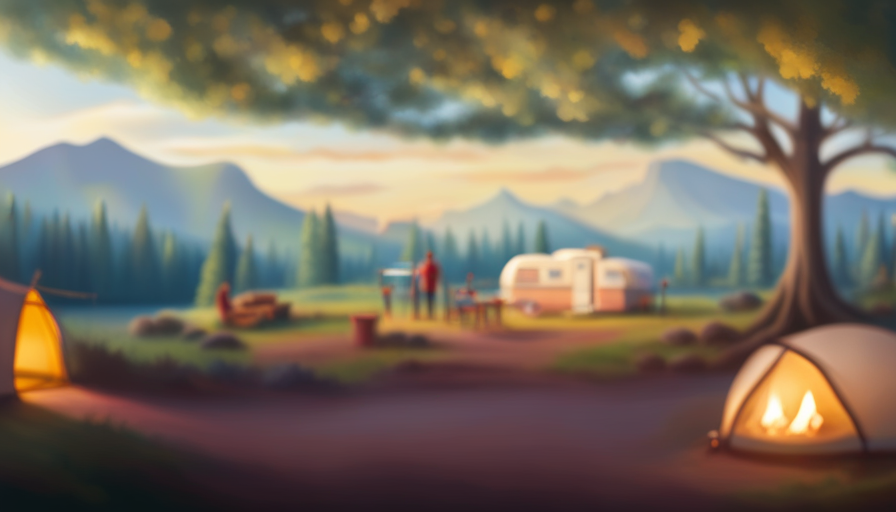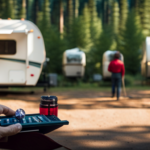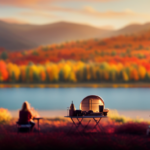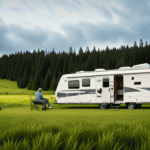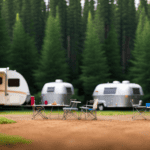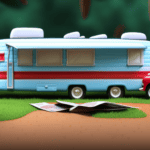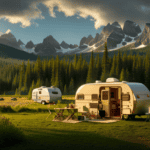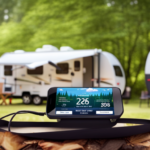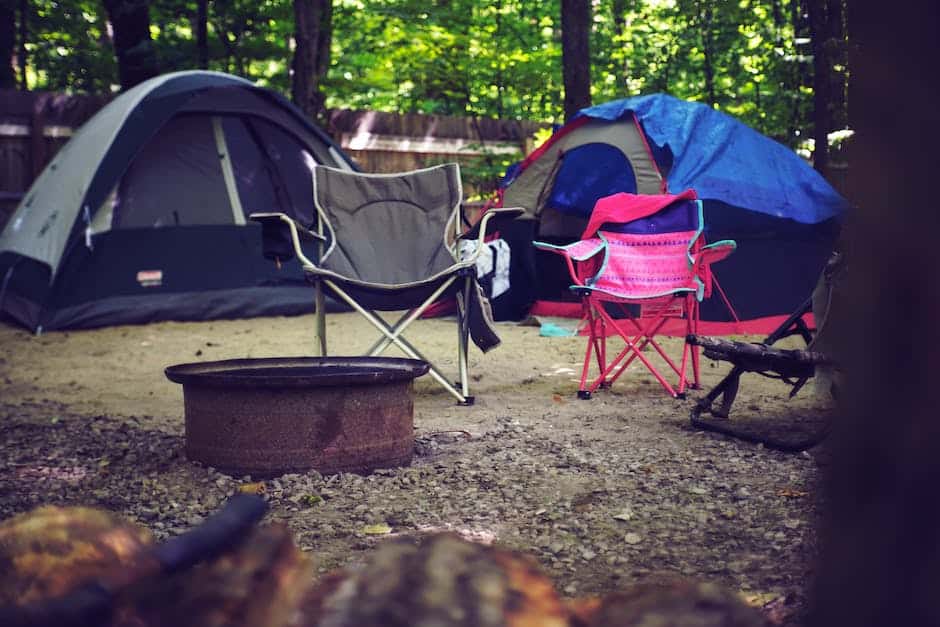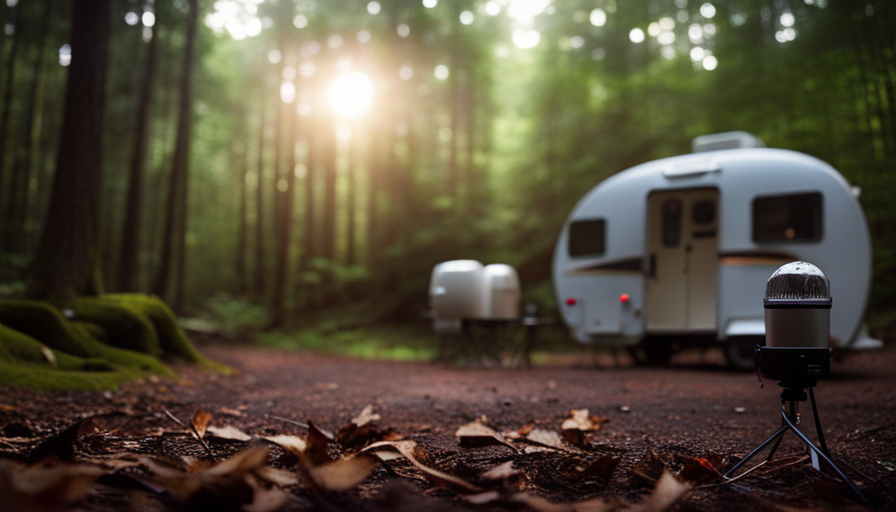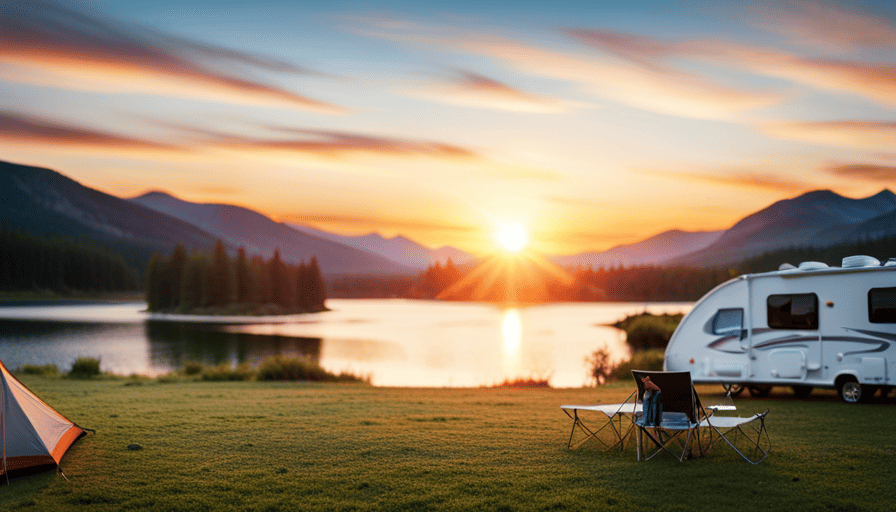Do you fantasize about venturing out on the open road and discovering the vast beauty of nature? Purchasing a pre-owned camper could be an excellent strategy to turn that dream into reality while keeping your finances intact. However, prior to loading up your gear and embarking on your journey, there are several important factors you must think about.
What should you look for when buying a used camper? We’ve got you covered. In this article, we’ll guide you through the process step by step, ensuring that you make an informed decision that meets your budget and needs.
From researching different camper types and brands to inspecting the exterior and interior for any signs of wear and tear, we’ll leave no stone unturned.
So, grab a cup of coffee, sit back, and let’s dive into the world of used campers together.
Key Takeaways
- Consider budget, needs, size, and amenities when buying a used camper
- Inspect both the exterior and interior for signs of damage, rust, water damage, and wear and tear
- Test the electrical system, plumbing system, tires, suspension, and overall functionality of the camper
- Get a professional inspection and review the maintenance and repair history before finalizing the purchase
Determine Your Budget and Needs
Now, let’s figure out how much we can spend and what we really need in a camper. Determining your budget and needs is crucial when buying a used camper.
First, let’s talk about choosing the right size. Consider the number of people who will be using the camper and the amount of space you will need. If you have a large family or plan on traveling with friends, a larger camper might be the best option. On the other hand, if you prefer a more compact and maneuverable camper, a smaller size would be more suitable.
Additionally, think about the amenities you require. Are you someone who enjoys cooking and needs a fully-equipped kitchen? Or maybe you prioritize a comfortable sleeping area with a cozy bed. It’s important to prioritize your needs and find a camper that aligns with them.
Once you have determined your budget and needs, it’s time to research different camper types and brands. This will help you narrow down your options and find the perfect camper for your adventures.
Research Different Camper Types and Brands
When exploring the market for a pre-owned recreational vehicle, it’s essential to delve into the vast array of camper models and brands available to ensure a well-informed purchasing decision. Researching different camper types and brands allows buyers to understand the specific features, amenities, and quality associated with each model.
By reading camper reviews and comparing different models, prospective owners can gain insights into the durability, performance, and overall satisfaction of previous owners.
One important aspect to consider is the type of camper that best suits your needs and preferences. There are various options available, including truck campers, travel trailers, fifth wheels, and motorhomes. Each type offers its own advantages and disadvantages, so it’s important to evaluate how you plan to use the camper and what amenities are essential for your trips.
Furthermore, researching different camper brands can help identify reputable manufacturers known for producing high-quality vehicles. By examining customer reviews and industry ratings, buyers can gain valuable insights into the reliability, customer service, and overall reputation of each brand.
With a thorough understanding of the available camper models and brands, buyers can make an informed decision when purchasing a used camper. By taking the time to research and compare options, you can ensure that you find the perfect camper that meets your needs and provides a reliable and enjoyable camping experience.
Now, let’s move on to the next step, where we will inspect the exterior for damage and rust.
Inspect the Exterior for Damage and Rust
First things first, take a thorough walk around the exterior of the camper and keep your eyes peeled for any signs of damage or rust – because remember, appearances can be deceiving, and it’s better to be safe than sorry!
Start by inspecting the overall condition of the exterior. Look for any dents, scratches, or cracks on the body. These could indicate previous accidents or rough handling. Pay close attention to the seams and joints as well, as these areas are prone to water leaks.
Next, pay special attention to any signs of rust. Rust can be a major headache down the road, so it’s important to catch it early. Check the frame, undercarriage, and any exposed metal surfaces for rust spots. If you find any, it’s crucial to address them promptly to prevent further damage. Look for signs of rust prevention measures, such as protective coatings or regular maintenance, as these indicate that the owner has taken steps to prevent rust.
In addition to damage and rust, be on the lookout for signs of water damage. Look for soft spots, discoloration, or bubbling on the exterior walls. These can be signs of water infiltration, which can lead to costly repairs.
Inspecting the exterior thoroughly for any signs of damage, rust, or water damage will give you a good idea of the camper’s overall condition.
Now, let’s move on to the interior and check for signs of wear and tear.
Check the Interior for Signs of Wear and Tear
Take a stroll inside and discover the charm of the camper’s interior while keeping an eye out for any signs of wear and tear.
Common interior issues to look out for include water damage, mold, and general wear on furniture and fixtures. Start by inspecting the walls and ceiling for any discoloration or soft spots, as these could indicate water damage. Look for any signs of mold or mildew, especially in the corners or around the windows. Pay attention to the flooring as well, checking for any warping or softness, which may indicate water damage or rot.
Next, examine the furniture and fixtures for wear and tear. Check the upholstery for stains, tears, or excessive wear. Test the drawers and cabinets to ensure they open and close smoothly. Look for any broken or missing hardware, such as handles or knobs. Don’t forget to inspect the kitchen appliances, including the stove, refrigerator, and microwave, to ensure they’re in working order.
How to spot hidden wear and tear? Look for any signs of mismatched paint or repairs, which could indicate that the camper has undergone previous damage. Check for any strange or musty odors that could suggest hidden issues.
Once you’ve thoroughly inspected the interior for signs of wear and tear, it’s time to test the electrical and plumbing systems.
Test the Electrical and Plumbing Systems
To truly understand the condition of the camper, it’s crucial to test both the electrical and plumbing systems.
When it comes to the electrical system, start by checking all the lights inside and outside the camper. Turn them on and off to ensure they’re functioning properly. Test all the outlets to make sure they’re providing power. You can bring along a small electrical device, like a phone charger, to plug into each outlet and see if it works. Additionally, check the battery and make sure it’s charging properly.
Moving on to the plumbing system, start by inspecting the water pump. Turn it on and off to see if it’s working smoothly without any strange noises. Check the water faucets and make sure they’re all functioning and providing a steady flow of water. Test the toilet by flushing it a few times to ensure it’s working properly and not leaking.
By thoroughly testing the electrical and plumbing systems, you can identify any potential issues and make a more informed decision when buying a used camper. Once you’ve completed this step, you can move on to the next section and examine the tires and suspension.
Examine the Tires and Suspension
Make sure you check out the condition of the tires and suspension in order to ensure a safe and smooth journey in your new adventure home. Here are a few things to consider when examining the tires and suspension:
-
Tire Pressure: Check the tire pressure to ensure that it’s within the recommended range. Low tire pressure can lead to poor handling and decreased fuel efficiency.
-
Tread Wear: Inspect the tires for any signs of uneven wear or bald spots. Uneven wear could indicate improper alignment or suspension issues.
-
Suspension Maintenance: Look for any signs of wear or damage to the suspension components, such as worn-out bushings or leaking shock absorbers. A well-maintained suspension system will provide a comfortable ride and better handling.
-
Spare Tire: Don’t forget to check the condition of the spare tire as well. It should be in good shape and properly inflated.
By examining the tires and suspension, you can ensure that your used camper is in good condition and ready for your adventures on the road. Once you’ve completed this inspection, it’s time to request the maintenance and repair history to get a better understanding of the camper’s overall condition.
Request the Maintenance and Repair History
Don’t miss out on the valuable information you can gain by requesting the maintenance and repair history of your potential adventure home. Checking the maintenance and repair history of a used camper is crucial in order to make an informed decision. By reviewing the history, you can get insights into how well the camper has been cared for and identify any potential red flags.
One important aspect to consider is water damage. Water damage can cause serious issues in a camper, leading to costly repairs. By examining the maintenance and repair history, you can determine if there have been any previous water damage incidents and if they were properly addressed. This information can help you assess the overall condition of the camper and decide if it is worth pursuing further.
Furthermore, buying a camper without a maintenance and repair history can pose significant risks. Without knowing the history, you may be unaware of any recurring problems or hidden issues that could be lurking. This could lead to unexpected expenses and frustrations down the road. It’s always better to have a clear understanding of the camper’s past maintenance and repairs to ensure you’re making a wise investment.
With the potential risks of buying a camper without a maintenance and repair history in mind, it’s essential to take a test drive and check the engine. This will allow you to assess the camper’s performance and ensure that it’s in good working condition.
Take a Test Drive and Check the Engine
Before taking a test drive and checking the engine, it’s important to ensure that the maintenance and repair history of the camper has been reviewed. This step is crucial because it provides insight into how well the camper has been cared for in the past and can give you an idea of any potential issues that may arise in the future. By requesting the maintenance history, you can see if the previous owner has kept up with regular service appointments and if any major repairs have been done. This information can help you determine if the camper has been well-maintained and if it’s worth pursuing further.
Once you have reviewed the maintenance history, it’s time to take the camper for a test drive and inspect the engine. During the test drive, pay attention to how the camper handles on the road. Test the brakes, acceleration, and steering to ensure everything feels smooth and responsive. Additionally, listen for any unusual noises coming from the engine or other components.
After the test drive, it’s recommended to have a professional inspection done on the camper. An experienced mechanic can thoroughly inspect the engine and other mechanical components to identify any potential issues that may not be obvious during a test drive. This inspection can give you peace of mind and help you make an informed decision about the camper’s condition.
Now that you have reviewed the maintenance history, taken a test drive, and inspected the engine, it’s time to negotiate the price and consider financing options.
Negotiate the Price and Consider Financing Options
Once you’ve thoroughly assessed the camper’s condition, it’s crucial to negotiate the price and explore financing options to ensure you’re getting the best deal possible.
When it comes to negotiating the price, there are a few tips that can help you succeed. First, do your research and know the market value of the camper you’re interested in. This will give you a baseline for negotiation and prevent you from overpaying.
Second, be prepared to walk away if the seller is not willing to come down on the price. This shows that you’re serious and not willing to settle for anything less than a fair deal.
Finally, be flexible and open to compromises. Sometimes, sellers may be willing to reduce the price if you’re willing to take care of certain repairs or maintenance.
In addition to negotiating the price, it’s important to consider financing options. There are pros and cons to both cash and financing. If you have enough cash on hand, paying in full can give you more bargaining power and save you from paying interest. However, financing can also be a viable option, especially if you don’t have the full amount upfront. Just make sure to carefully consider interest rates and loan terms to ensure you’re getting a good deal.
After negotiating the price and considering financing options, it’s essential to get a professional inspection before finalizing the purchase. This will provide you with an unbiased assessment of the camper’s condition and help you make an informed decision.
Get a Professional Inspection Before Finalizing the Purchase
Make sure to schedule a professional inspection to ensure you’re making a wise investment in your new adventure on wheels. When buying a used camper, it’s crucial to have a professional inspect it thoroughly.
A professional inspection can provide numerous benefits and help you make an informed decision. One of the key benefits of a professional inspection is that it can uncover any hidden issues or problems with the camper. While a visual inspection can give you a general idea of the camper’s condition, a professional inspector has the knowledge and expertise to identify potential problems that may not be immediately apparent.
They’ll thoroughly examine the camper’s structure, mechanical systems, electrical systems, plumbing, and appliances, providing you with a comprehensive assessment of its condition.
Another important aspect of a professional inspection is that it can help you negotiate the price. If the inspection reveals any issues or necessary repairs, you can use this information to negotiate a lower price or request that the seller address the problems before finalizing the purchase.
In addition to uncovering hidden issues and assisting with price negotiation, a professional inspection provides peace of mind. Knowing that a trained expert has thoroughly inspected the camper can give you confidence in your investment and help prevent any unexpected surprises down the road.
A professional inspection is of utmost importance when buying a used camper. It offers numerous benefits, including uncovering hidden issues, assisting with price negotiation, and providing peace of mind. By investing in a thorough inspection, you can ensure that you’re making a wise decision and embarking on your new adventure with confidence.
Frequently Asked Questions
Can I negotiate the price even if the camper is in good condition?
Yes, you can negotiate the price of a used camper even if it’s in good condition. When negotiating, it’s important to consider factors such as market value, age, mileage, and any potential repairs or maintenance needed. While a camper in good condition may be priced higher, it doesn’t mean there isn’t room for negotiation. It’s always worth discussing the price with the seller and presenting any relevant information or concerns to help reach a fair agreement.
What are the common issues with camper electrical systems?
Common camper electrical issues can include faulty wiring, blown fuses, malfunctioning appliances, and battery problems. To troubleshoot these problems, start by checking the fuse box and replacing any blown fuses.
Inspect the wiring for any signs of wear or damage.
Test the appliances to ensure they’re functioning properly.
If the camper has a battery, check its condition and connections.
If issues persist, it may be necessary to consult a professional electrician for further assistance.
Should I consider financing options even if I have enough money to purchase the camper outright?
When considering financing options for a camper, it’s important to weigh the advantages.
Interestingly, a recent study found that over 60% of people who could afford to buy a camper outright still chose to finance it. Financing allows you to preserve your cash for other investments or unexpected expenses. Additionally, it can help you establish credit or improve your credit score.
However, it’s essential to compare cash vs. loan options, considering interest rates and potential fees to make an informed decision.
What are the signs of a well-maintained camper?
When inspecting a used camper, there are several signs to look for that indicate it has been well-maintained. First, check for any hidden water damage, such as soft spots on the walls or ceiling, as this can be a costly issue to repair.
Additionally, examine the camper’s exterior for any signs of rust, dents, or leaks. Look closely at the seams and joints to ensure they’re intact.
These tips will help you make a more informed decision when purchasing a used camper.
How important is it to get a professional inspection before buying a used camper?
Getting a professional inspection before buying a used camper is crucial. It’s like getting a mechanic to inspect a used car before buying it.
An expert can spot hidden issues that the average person might miss. While DIY inspections can be helpful, they may not catch all potential problems.
Additionally, buying from a reputable dealer can provide added peace of mind. They often have thorough inspections and offer warranties, ensuring you get a camper in good condition.
What Features Should I Consider When Choosing a Truck for a Truck Camper?
When selecting a truck for a truck camper, it is essential to carefully evaluate various truck camper options. Consider the truck’s payload capacity, ensuring it can safely carry the added weight. Adequate suspension and towing capacity are also crucial for a smooth and stable ride. Additionally, features like a reinforced frame, four-wheel drive, and an extended cab can enhance the overall camper experience.
Conclusion
In conclusion, when buying a used camper, it’s important to approach the process with caution and thoroughness.
Just as a seasoned adventurer would meticulously plan their journey, we too must carefully consider our budget, research different camper types, and inspect for any potential issues.
It’s like embarking on a grand voyage, where each step is taken with care and precision.
By following these steps, we can find the perfect used camper that will take us on countless unforgettable adventures.
Happy travels!


